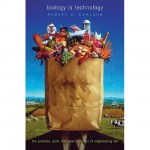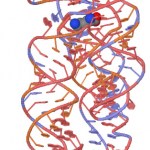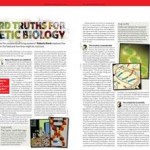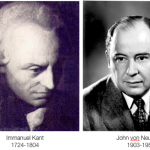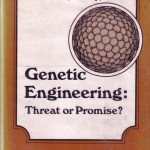synthetic biology
"The history of any given technology is extraordinarily complex."
--Rob Carlson, Biology is Technology.
Analyzing the history of a technology requires a complex look at the social, economic, and political context in which it emerged, and the reciprocal influences that the developing technology exerts on these factors. Predicting what the future of a technology will be like, how it will affect the economy and understanding the potential risks and payoffs is much much harder. Rob Carlson's new book, Biology is Technology: The Promise, Peril, and New Business of…
Teachers' Domain, a digital media resource for teachers, profiled Karmella Haynes, one of my amazing labmates!
There's a fun video of Karmella talking about her work on synthetic biology devices to track cancer cells and about careers in science streaming on the Teachers' Domain website. You should all check it out, she's an incredible scientist, artist, and teacher--a true inspiration!
Synthetic biology is still a new field, and victories are small and incremental. Much of the promise and peril of synthetic biology still lies in the future: genetic devices made to order, computer aided genome design, organisms specially constructed for specific industrial purposes. Will we use this biological technology for good--new more affordable and accessible drugs, better vaccines to emerging diseases, and clean energy--or evil--new deadly pathogens and immortal super soldiers? I think it's safe to say that almost everyone hopes that we'll get all of the good stuff without any of the…
Today in my searches for the hot new trends in synthetic biology, I found a news article from Science Daily with an intriguing title: "Scientists Achieve First Rewire of Genetic Switches." Rewiring genetic switches sounds pretty neat, but this headline was intriguing to me first of all because it's kind of late to the party--in fact one of the first papers in modern synthetic biology back in 2000 was about engineered genetic switches: "Construction of a genetic toggle switch in Escherichia coli". When I looked more closely, the article wasn't about this kind of transcriptional switch though,…
Things are gearing up for iGEM 2010, and in looking through some of the incredible work of the 2009 teams, I remembered the University of Washington Software team, who made an awesome lego robot that can move small volumes of liquid around in 96-well plates, a crucial and typically very expensive task in high-throughput biology. What makes the team especially remarkable is that the only member is an 11 year old kid, Gabriel See, who designed and built the robot on his own. Gabriel had the flu during the jamboree, so he unfortunately couldn't fly to MIT to share his work, but he did get his…
Cooperation and altruism are widespread in biology, from molecules and genes working together in a cell, to bacterial communities that require coordinated behavior to survive in a tough environment, to human relationships and societies. Our human cultural perspective (perhaps even more specifically our American cultural perspective, focused as it is on individuality, free markets, and the American Dream), however, treats cooperation as an outright anomaly that has to be explained away by science (or often, religion). If natural selection is about the "survival of the fittest" how can a…
On Oscillator, Christina Agapakis lays out some of the history of synthetic biology. While in the last century this field has employed molecular and informational toolkits, in centuries past inventors relied on grosser modes of simulation. Such was the case with eighteenth century wetware, which aspired "to make machines look and feel more like living things—soft, flexible, moist." One of the grails of early synthetic biology was the simulation of the human voice, and to this end we see such terrors as a fake face attached to a phonetic keyboard, which allowed "an operator to play a '…
Oscillators are huge in synthetic biology. They're an exciting challenge, very hard to make in a controlled, robust way, they have the potential to be useful in many applications, like well-timed drug delivery, and they can tell us a lot about how natural circadian rhythms work. A new paper in this week's issue of Nature from Jeff Hasty's group at UCSD presents a new synthetic biological oscillator in bacteria. While there have been a lot of oscillators designed in the past few years, this one is special because it couples oscillations in fluorescence to bacterial quorum sensing, allowing the…
Nature News has an excellent article about the hype, the challenges, and the potential of synthetic biology. The article quotes Martin Fussenegger, a leader in mammalian cell synthetic biology as saying "The field has had its hype phase, now it needs to deliver." In order to do so researchers will have to overcome five main challenges:
Many of the parts are undefined
The circuitry is unpredictable
The complexity is unwieldy
Many parts are incompatible
Variability crashes the system
The article is a great read, and includes interviews with many of the big names in the field, as well as…
Modern day biological engineering and artificial life research focuses on the microscopic, the molecular, the informational, the stuff of the scientific revolutions of the past one hundred years. Our current synthetic biologies aim to turn the living into the designed, the wet into the computational, the complex into the understandable. In the 1700's, the interplay between the living and the mechanical was reversed; engineers were trying to make machines look and feel more like living things--soft, flexible, moist. Studying these historical artificial life technologies provide a valuable…
Many synthetic biologists cite one of Richard Feynman's many famous quotations as the inspiration for their work: "What I cannot create I do not understand." For synthetic biology the interpretation is clear--only by designing and building living systems will we truly understand the principles underlying the functions of living cells.
This connection between knowing and making that defines much of synthetic biology research today is, however, a much older idea, rooted in the philosophy of the enlightenment and centuries of western science. The 18th century philosopher Giambattista Vico said…
Awful Library Books has a post on books about genetic engineering from the 1970's and 80's, saying that it's time to get rid of them because "Genetic information is dramatically different from what we knew in the 70's and 80's. No mention of Human Genome Project or Dolly, the sheep." If you're looking for information about cutting-edge genetic engineering you're probably better off not looking for a book at all, but while science is inherently focused on the future, a historical perspective is almost always valuable, especially when it comes to genetic engineering and synthetic biology.
The…
iGEM is all about synthetic biology, kids. It's the annual International Genetically Engineered Machine competition.
Each team in the IGEM competition has to make something using a kit of biological parts from the Registry of Standard Biological Parts. Teams of students use these parts to design, build, and operate biological systems in living cells.
IGEM began in 2003 with a course at MIT where students made cells blink. Now, this year had:
1200 participants,
84 teams,
and 24 awards.
Amazingly, two of those awards went to a team (UCSF) composed mostly of students from a public high…
This story reminds me of those days not so long ago when I was teaching molecular biology to a small group of motivated and talented high school sophomores and juniors. Basically, a group of high school biotechnology seniors from Abraham Lincoln High School in San Francisco, California, were invited to participate in the international Genetically Engineered Machine competition (iGEM), hosted at the Massachusetts Institute of Technology. iGEM focuses on the hot new field of synthetic biology: this field genetically manipulates proteins and other molecules that are constructed by living cells…
